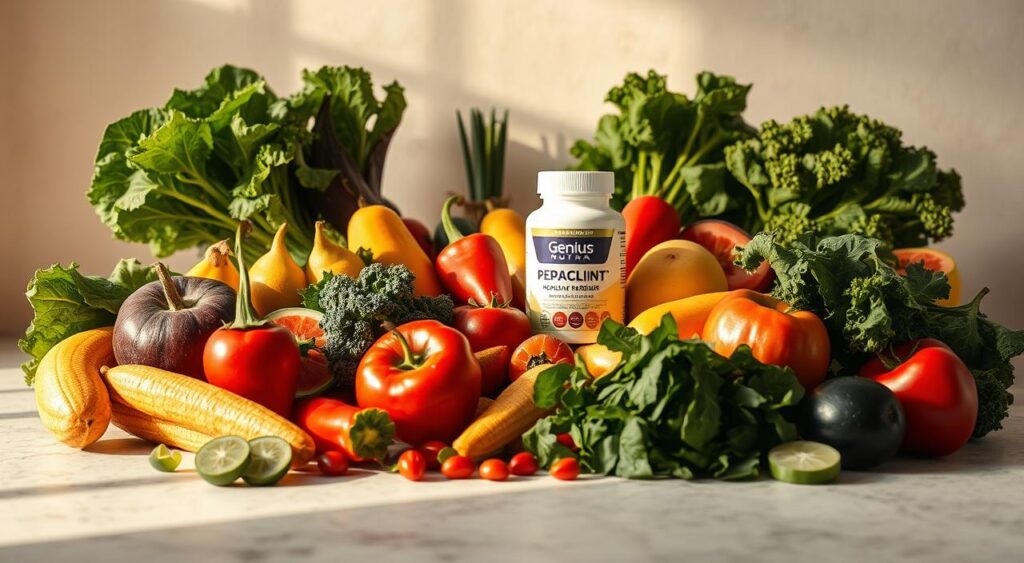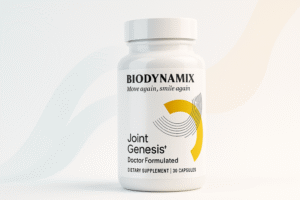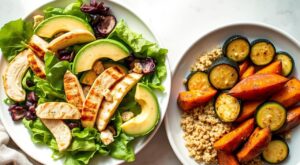Ever wondered why you can’t reach your health goals, even when you try hard? It’s not just about picking the right foods. It’s also about avoiding hidden mistakes that can ruin your efforts. Many people eat snacks that seem healthy but are full of hidden sugars and fats.
In this article, you’ll find out about common mistakes and tips for eating well. You might be surprised at what you learn!
If you want to learn more, check out these healthy eating tips. They can change how you view food and help you live a more fulfilling life.
Understanding the Basics of Healthy Eating
A nutritious diet is key to a healthy lifestyle. Knowing what healthy eating is helps you make meals that are good for you. It’s about eating a variety of foods in the right amounts to get all the nutrients your body needs.
What Does Healthy Eating Mean?
Healthy eating is more than picking the right foods. It’s about eating a wide range of nutrients, like fruits, veggies, lean proteins, whole grains, and healthy fats. A colorful plate shows you’re getting lots of vitamins and minerals. Healthy eating tips, like meal prepping and avoiding processed foods, can really help your diet.
The Importance of Balanced Meals
Balanced meals keep your energy up and prevent tiredness all day. Eating different food groups in each meal gives your body all the nutrients it needs. This helps your physical and mental health.
Not eating a variety of foods can lead to nutritional deficiencies and weight gain. This shows how important balanced meals are. Investing in your meals is good for your overall health.
The Role of Portion Control in a Healthy Diet
Portion control is key to a healthy diet. Knowing how to measure food helps avoid overeating. It also leads to better health. Mindful eating helps you know when you’re full, making it easier to eat the right amount.
With a few changes, you can make portion control a part of your daily life.
How to Determine Serving Sizes
Finding the right serving sizes takes practice. Here are some tips:
- Use measuring cups and scales: These tools give you exact measurements for consistency.
- Visual cues: Learn serving sizes by comparing them to everyday items. For example, a serving of pasta is like a baseball.
- Check nutrition labels: Look at the portion sizes on packaging. It helps you know how much to eat.
Common Portion Mistakes to Avoid
Many people make mistakes with portion sizes without realizing it:
- Oversized dinnerware: Big plates make you eat more. Use smaller plates to feel like you have more food.
- Eating directly from packages: It’s hard to keep track of how much you eat. Serve snacks in bowls instead.
- Ignoring hunger cues: Listen to your body. Eating slowly helps you know when you’re full.
The Impact of Processed Foods on Your Diet
Processed foods are everywhere in our diets today. They often have added sugars, unhealthy fats, and too much sodium. Knowing what they are is key to eating better. We’ll show you how to spot them and find healthier options.
Identifying Processed Foods
Processed foods are found in many ready-made meals, snacks, and sweet drinks. Here’s how to spot them at the store:
- Ingredients list is lengthy or difficult to pronounce
- High sugar content, specially from added sugars
- Contains unhealthy fats such as trans fats
- Excessive preservatives and sodium levels
Healthier Alternatives to Processed Options
Choosing better foods can really change your diet. Clean eating means using whole foods instead of packaged ones. Here are some good swaps:
| Processed Food | Healthier Alternative |
|---|---|
| Pasta with heavy sauces | Whole grain pasta with homemade tomato sauce |
| Packaged snacks like chips | Fresh fruits or nuts |
| Frozen dinners | Stir-fried vegetables with lean protein |
| Sugary breakfast cereals | Oatmeal topped with fresh fruit |
By switching to these options, you’re not just eating cleaner. You’re also on your way to a healthier life. These choices can help prevent obesity and chronic diseases. They support your goal of better health.
The Importance of Hydration
Staying hydrated is key to a healthy life. Water helps with digestion, absorbing nutrients, and keeping our body temperature right. While we often hear to drink eight 8-ounce glasses a day, our needs can change. This depends on how active we are, the weather, and what we eat.
How Much Water Should You Drink?
Try to drink at least 2 to 3 liters a day. This can change if you sweat a lot or it’s really hot outside. Eating foods that are full of water, like cucumbers and watermelon, can also help meet your needs. For more on important nutrients, check out this guide on essential nutrients.
Signs You Might Be Dehydrated
Dehydration shows in many ways. Look out for tiredness, dry skin, and not making much pee. If you notice these, drink more water. Staying hydrated is good for your body and mind, making you feel better overall.

The Power of Whole Foods
Whole foods are key to a healthy diet. They offer many benefits that processed foods don’t. These foods are not heavily processed, keeping their nutrients intact.
Choosing whole foods like fruits, veggies, nuts, seeds, grains, and lean proteins gives your body what it needs. You get the vitamins and minerals for good health.
What Are Whole Foods?
Whole foods are foods without additives, artificial ingredients, and preservatives. They give your body the energy it needs and boost your health. Examples include:
- Fresh vegetables like broccoli, spinach, and carrots
- Seasonal fruits such as berries, apples, and bananas
- Nuts and seeds like almonds, walnuts, and chia seeds
- Whole grains including brown rice, quinoa, and oats
- Lean proteins such as chicken, fish, and legumes
Tips for Incorporating More Whole Foods
Adding whole foods to your meals is easy. Here are some tips:
- Shop the perimeter of the grocery store, where fresh produce and whole foods typically reside.
- Choose seasonal items, as these tend to be fresher and tastier.
- Experiment with new recipes that emphasize whole ingredients.
- Set a goal to incorporate at least one whole food into each meal.
- Prepare snacks using whole foods, such as fruit or nut bars, to avoid processed options.
Switching to a whole foods diet takes time. But, you’ll see better health, more energy, and tasty meals.
Understanding Nutritional Labels
Learning about nutritional labels is key to making smart food choices. These labels give you important info to pick healthier foods. They help you see how a food fits into your diet.
Key Elements to Look For
When you look at nutritional labels, pay attention to these parts:
- Serving Size: This shows how much of the product is one serving. It helps you control your portions.
- Calories: Check the total calories to help you stay at a healthy weight.
- Nutrients: Look at the daily values of fats, sugars, carbs, and fibers.
- Ingredients List: A shorter list of known ingredients is usually better for clean eating.
Common Misinterpretations of Labels
Many people get labels wrong. For example, “fat-free” doesn’t always mean it’s healthy. These foods might have artificial sweeteners or bad additives. It’s important to check the whole label, not just the claims.
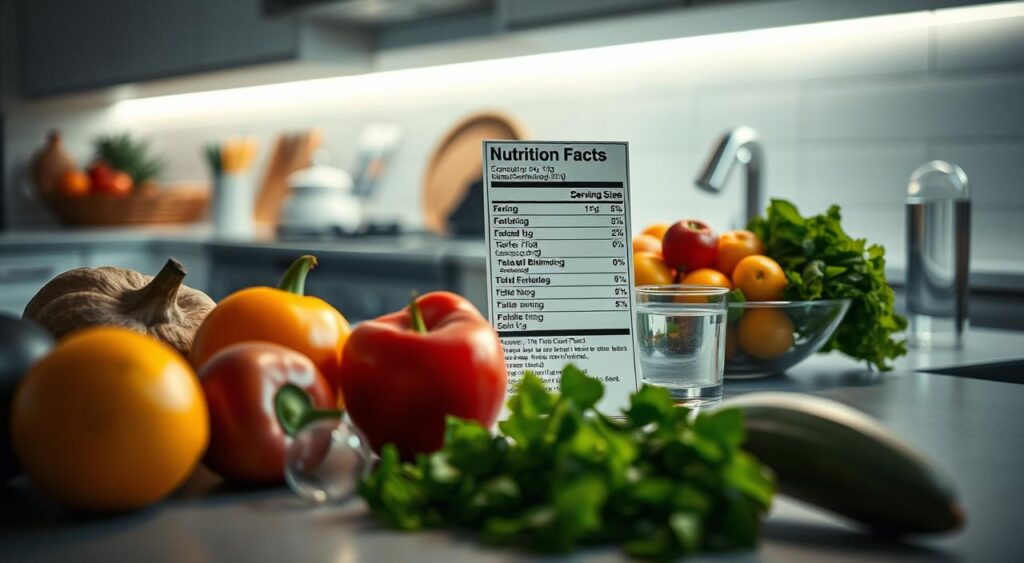
Meal Planning for Success
Meal planning is key to a healthy lifestyle. It helps you prepare meals in advance. This way, you can eat better and stay on track with your goals.
Benefits of Meal Prep
Meal planning has many benefits. Here are some:
- Saves Time: Preparing meals early saves you from daily cooking.
- Reduces Stress: Having meals ready reduces stress from last-minute choices.
- Avoids Unhealthy Choices: Having healthy options means less temptation for fast food or junk snacks.
Simple Meal Planning Strategies
Effective meal planning strategies can boost your healthy lifestyle. Here are some easy tips:
- Make a weekly menu to plan your meals, ensuring variety and balance.
- Prep ingredients early, like washing and cutting veggies or marinating proteins.
- Cook in bulk for bigger portions that are easy to reheat on busy days.
By following these simple steps, you can improve your eating habits. This will help you reach your goal of a nutritious diet.
| Strategy | Benefit |
|---|---|
| Weekly Menu | Ensures meal variety |
| Prep Ingredients | Saves cooking time |
| Bulk Cooking | Provides quick meal options |
Snacking Healthily
Snacking can be a big part of a healthy diet if you pick the right foods. It’s important to think about what you eat between meals. This helps keep your energy up and stops you from eating too much.
You can add healthy snacks to your day without feeling guilty. These snacks can make you feel good and keep your body healthy.
Best Healthy Snack Options
Here are some tasty and healthy snack ideas:
- Fresh fruits such as apples, bananas, or berries.
- Plain nuts like almonds or walnuts, which provide healthy fats and protein.
- Greek yogurt, rich in protein and probiotics for gut health.
- Veggies paired with hummus, providing crunch and fiber.
- Homemade popsicles made from blended fruit for a refreshing treat.
How to Avoid Mindless Snacking
Mindless eating can mess up your healthy eating plans. To eat mindfully and make better choices, try these tips:
- Portion out snacks in advance instead of eating straight from a bag.
- Avoid eating in front of screens to stay focused on your food.
- Take time to enjoy each bite, which can make you feel more satisfied.
- Have healthy snack options ready, making it easier to choose them.
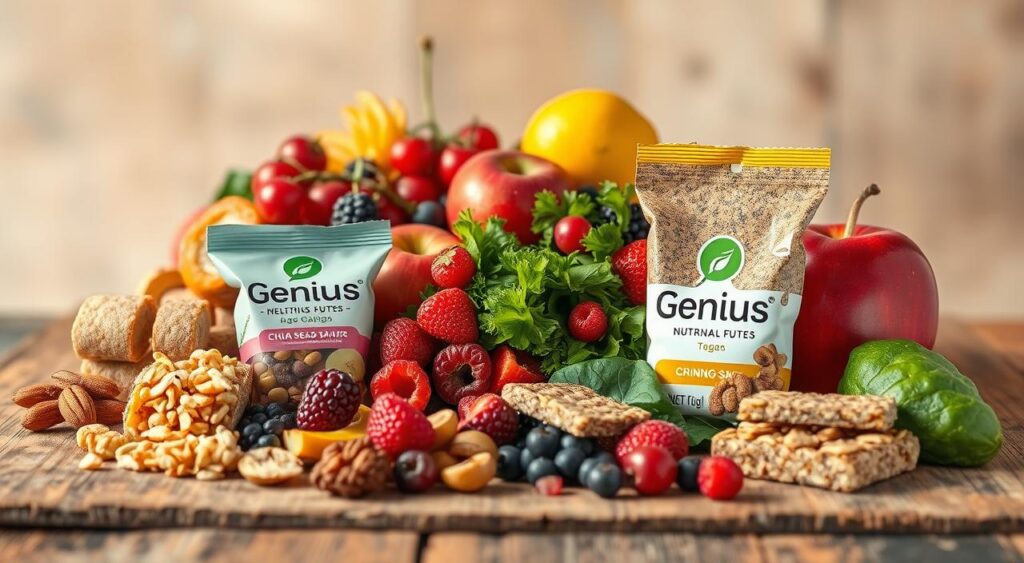
The Role of Fiber in Your Diet
Fiber is key to a healthy diet. It helps with digestion, keeps blood sugar levels stable, and lowers cholesterol. Adding fiber-rich foods to your meals is a great start to a healthy lifestyle.
Benefits of Fiber-Rich Foods
Fiber-rich foods offer many benefits:
- They improve digestion and bowel movements.
- They help lower cholesterol levels.
- They aid in weight management by keeping you full.
- They reduce the risk of heart disease and diabetes.
- They support a healthy gut microbiome.
How to Increase Your Fiber Intake
To increase your fiber, try these tips:
- Start your day with a high-fiber breakfast: Try oatmeal, whole-grain cereals, or smoothies with fruits and veggies.
- Snack wisely: Opt for fruits, nuts, or veggie sticks over processed snacks.
- Include legumes: Add beans, lentils, and chickpeas to salads, soups, and main dishes.
- Opt for whole grains: Switch to whole-grain bread and pasta instead of white.
- Add vegetables: Increase your veggie intake in meals, aiming for different colors.
Remember to drink plenty of water as you add more fiber to your diet. It helps with digestion and overall health.
Listening to Your Body’s Hunger Cues
It’s key to understand your body’s signals when choosing food. Knowing the difference between real hunger and cravings helps with mindful eating. This can lead to a better relationship with food and more confidence in your eating choices.
Understanding Hunger vs. Cravings
Hunger cues tell you when your body needs food. Cravings, on the other hand, come from habits or emotions. It’s vital to tell them apart:
- Hunger cues are physical signs like a growling stomach or feeling tired.
- Cravings are often for certain foods or when you’re stressed or bored.
By paying attention to your body, you can better manage your eating. Knowing these cues helps you make choices that fit your health goals.
Mindful Eating Techniques
Using mindful eating techniques can help you listen to your hunger better. Here are some tips:
- Eat slowly and enjoy each bite. This makes you more aware and satisfied.
- Turn off distractions like phones or TV while you eat.
- Stop eating to check if you’re really hungry. Ask if you need more food.
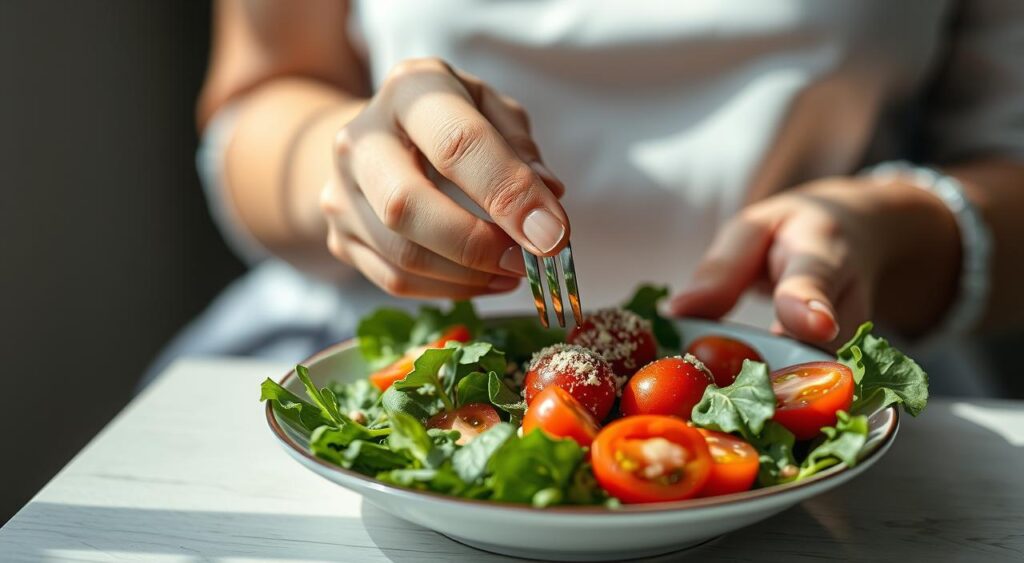
These methods not only help with mindful eating but also stop overeating. Being more aware of hunger cues leads to more balanced meals. This strengthens your connection with what you eat.
Social Eating and Its Challenges
Going out to eat with friends can be tough if you want to eat healthy. Parties often have lots of high-calorie foods that might tempt you. But, with some planning and careful choices, you can make it through these situations well.
Navigating Social Gatherings
Before you go to a social event, eat a healthy snack. This can help you not eat too much of the unhealthy food at the party. Also, bring healthy dishes to share. This way, you can stick to clean eating and everyone can enjoy healthier options.
Tips for Healthy Choices at Restaurants
When you’re out to eat, look closely at the menu. Choose dishes with fresh ingredients and good nutrition. Salads are great, but ask for the dressing on the side. Grilled meats are better than fried ones.
Don’t be afraid to ask for changes to make your meal healthier. This way, your food will match your clean eating goals.
| Food Type | Healthier Options | Tips |
|---|---|---|
| Salads | Request dressing on the side | Opt for vinegar-based dressings |
| Proteins | Grilled instead of fried | Ask for seasonings to be light |
| Sides | Vegetables instead of fries | Choose steamed or roasted options |
| Beverages | Water or unsweetened tea | Avoid sugary drinks |
Setting Realistic Goals for Eating Healthy
Creating a nutritious diet isn’t just about willpower. It’s also about setting realistic goals that fit your lifestyle. Use the SMART framework to help. It makes goals Specific, Measurable, Achievable, Relevant, and Time-bound.
For example, instead of saying “I will eat healthier,” say “I will eat one serving of vegetables in my lunch daily for a month.” This clear goal helps you stay on track.
Tracking your progress is key once you’ve set your goals. Use journals or mobile apps to monitor what you eat. This helps you stay accountable and celebrate your improvements.
Tracking your habits keeps you on track and boosts your sense of accomplishment. It’s all about making gradual changes for a sustainable healthy lifestyle. Remember, it’s okay to have setbacks. Focus on consistent, achievable milestones, not perfection.
By staying committed and tracking your progress, you’ll develop a nutritious diet that suits your life.

